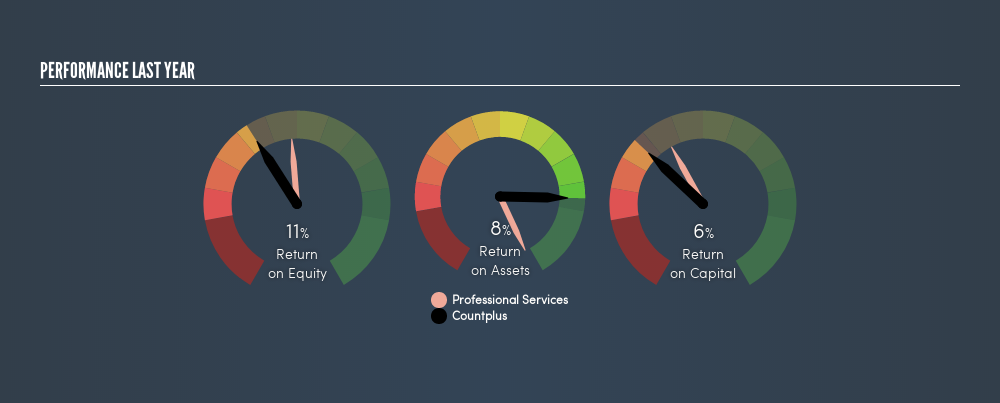- Australia
- /
- Professional Services
- /
- ASX:CUP
Should Countplus Limited’s (ASX:CUP) Weak Investment Returns Worry You?

Today we'll look at Countplus Limited (ASX:CUP) and reflect on its potential as an investment. Specifically, we're going to calculate its Return On Capital Employed (ROCE), in the hopes of getting some insight into the business.
Firstly, we'll go over how we calculate ROCE. Next, we'll compare it to others in its industry. Last but not least, we'll look at what impact its current liabilities have on its ROCE.
Return On Capital Employed (ROCE): What is it?
ROCE is a measure of a company's yearly pre-tax profit (its return), relative to the capital employed in the business. In general, businesses with a higher ROCE are usually better quality. In brief, it is a useful tool, but it is not without drawbacks. Author Edwin Whiting says to be careful when comparing the ROCE of different businesses, since 'No two businesses are exactly alike.'
So, How Do We Calculate ROCE?
The formula for calculating the return on capital employed is:
Return on Capital Employed = Earnings Before Interest and Tax (EBIT) ÷ (Total Assets - Current Liabilities)
Or for Countplus:
0.064 = AU$4.2m ÷ (AU$76m - AU$11m) (Based on the trailing twelve months to December 2018.)
So, Countplus has an ROCE of 6.4%.
Check out our latest analysis for Countplus
Does Countplus Have A Good ROCE?
ROCE can be useful when making comparisons, such as between similar companies. In this analysis, Countplus's ROCE appears meaningfully below the 19% average reported by the Professional Services industry. This performance is not ideal, as it suggests the company may not be deploying its capital as effectively as some competitors. Aside from the industry comparison, Countplus's ROCE is mediocre in absolute terms, considering the risk of investing in stocks versus the safety of a bank account. Investors may wish to consider higher-performing investments.
Countplus's current ROCE of 6.4% is lower than 3 years ago, when the company reported a 8.5% ROCE. Therefore we wonder if the company is facing new headwinds.

Remember that this metric is backwards looking - it shows what has happened in the past, and does not accurately predict the future. ROCE can be misleading for companies in cyclical industries, with returns looking impressive during the boom times, but very weak during the busts. ROCE is, after all, simply a snap shot of a single year. Since the future is so important for investors, you should check out our freereport on analyst forecasts for Countplus.
Countplus's Current Liabilities And Their Impact On Its ROCE
Liabilities, such as supplier bills and bank overdrafts, are referred to as current liabilities if they need to be paid within 12 months. Due to the way ROCE is calculated, a high level of current liabilities makes a company look as though it has less capital employed, and thus can (sometimes unfairly) boost the ROCE. To counteract this, we check if a company has high current liabilities, relative to its total assets.
Countplus has total liabilities of AU$11m and total assets of AU$76m. As a result, its current liabilities are equal to approximately 14% of its total assets. This is a modest level of current liabilities, which would only have a small effect on ROCE.
Our Take On Countplus's ROCE
That said, Countplus's ROCE is mediocre, there may be more attractive investments around. Of course, you might find a fantastic investment by looking at a few good candidates. So take a peek at this freelist of companies with modest (or no) debt, trading on a P/E below 20.
If you like to buy stocks alongside management, then you might just love this freelist of companies. (Hint: insiders have been buying them).
We aim to bring you long-term focused research analysis driven by fundamental data. Note that our analysis may not factor in the latest price-sensitive company announcements or qualitative material.
If you spot an error that warrants correction, please contact the editor at editorial-team@simplywallst.com. This article by Simply Wall St is general in nature. It does not constitute a recommendation to buy or sell any stock, and does not take account of your objectives, or your financial situation. Simply Wall St has no position in the stocks mentioned. Thank you for reading.
About ASX:CUP
Count
Provides accounting, business advisory, and financial planning services in Australia.
Reasonable growth potential and fair value.
Market Insights
Community Narratives





